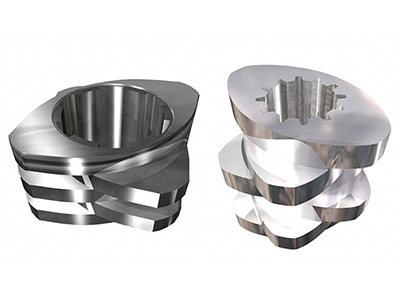Copyright © Shanghai Omega Machinery Co., Ltd. All rights reserved.
What are the mixing elements in twin screw extruder?
Dec 01,2023
Conveying Elements: These elements transport the material along the screw axis. They typically have a low pitch and are responsible for moving the material from the feed zone to the other processing zones.
Kneading Blocks or Kneading Elements: These elements create a shearing and kneading action, which is crucial for mixing and distributive mixing. They are designed to fold, stretch, and compress the material, enhancing the dispersion of additives and achieving uniform mixing.
Distributive Mixing Elements: These elements are designed to enhance the distribution of different components within the material. They typically have a forward-conveying and backward-conveying element, promoting axial mixing.
Maddock Elements: Maddock elements consist of small paddles or blades that create localized turbulence. They help break up agglomerates and improve distributive mixing.
Mixing Pins: Mixing pins are short, pin-like elements that extend radially into the screw channel. They provide additional shear and kneading forces, aiding in mixing and dispersive mixing.

Barrier Elements: Barrier elements consist of barriers or dams that interrupt the flow of material, creating zones of stagnation and intense mixing. This promotes distributive mixing and can enhance dispersion.
Madison Elements: Madison elements have a special geometry that imparts a combination of conveying and kneading actions. They contribute to both distributive and dispersive mixing.
Wave Elements: Wave elements have a wave-like geometry, creating additional turbulence and shear forces. They are effective in breaking down agglomerates and enhancing mixing.
The combination and arrangement of these mixing elements can be customized based on the specific requirements of the extrusion process and the materials being processed. The goal is to achieve a uniform and homogenous melt with the desired properties.
Prev News Next News
- Information
- What causes the uneven surface and poor gloss of the sheet during the sheet extrusion process? How can it be solved?
- Why does the cooling process for profile extrusion become unbalanced?
- What countermeasures can be taken to improve the dimensional and positional accuracy of profiles during the profile production process?
- How should profile molds be cleaned and maintained?
- What are the corresponding solutions to the phenomenon of grooves and pits on the surface of profiles?
- How should the raw materials be selected in the formula for PVC surface skin core layer microcellular foamed extruded profiles?
- How should the production process of biaxially oriented polyethylene terephthalate (BOPET) film be controlled?
- How should the longitudinal and transverse stretching be controlled when producing biaxially oriented films by the flat film method?
- How should the counter-rotating conical twin-screw extruder be operated for no-load test run?
- What are the characteristics of extrusion blow molding molds?
- Contact Us

-
Shanghai Omega Machinery Co., Ltd.
Add.: No.168 Hualian Road, Putuo District, Shanghai City
Contact: Nina
Tel.: +86-021-69921527
Mobile: +86-15021464410
Fax: +86-021-69921567
E-mail: omegajessica@163.com;965425705@qq.com
WeChat No.: 1131449532
-